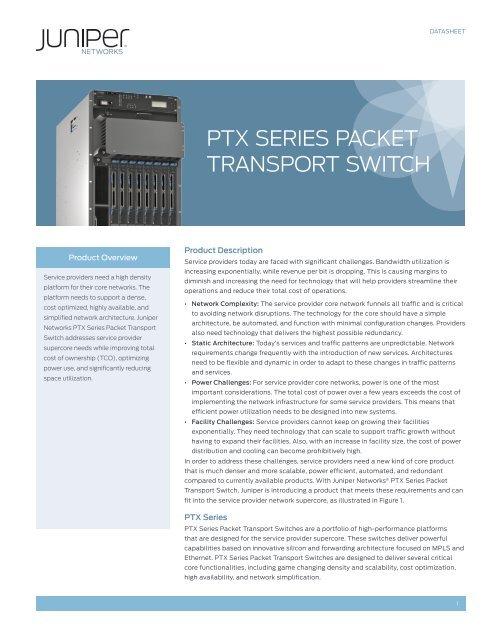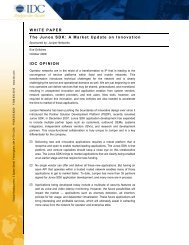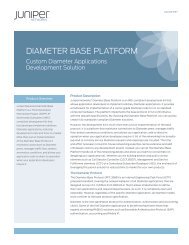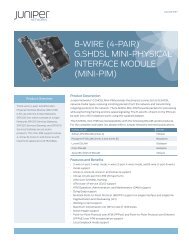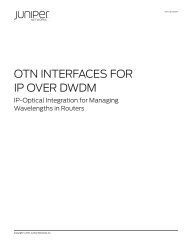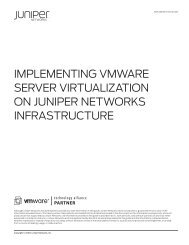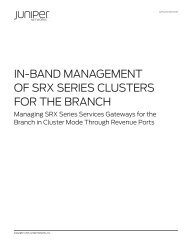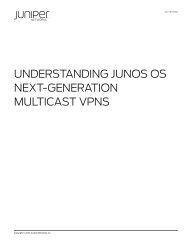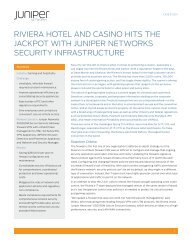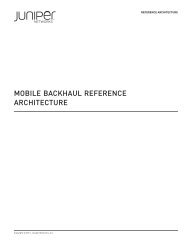Download - ICT Networks
Download - ICT Networks
Download - ICT Networks
You also want an ePaper? Increase the reach of your titles
YUMPU automatically turns print PDFs into web optimized ePapers that Google loves.
DATASHEET<br />
PTX Series Packet<br />
Transport Switch<br />
Product Overview<br />
Service providers need a high density<br />
platform for their core networks. The<br />
platform needs to support a dense,<br />
cost optimized, highly available, and<br />
simplified network architecture. Juniper<br />
<strong>Networks</strong> PTX Series Packet Transport<br />
Switch addresses service provider<br />
supercore needs while improving total<br />
cost of ownership (TCO), optimizing<br />
power use, and significantly reducing<br />
space utilization.<br />
Product Description<br />
Service providers today are faced with significant challenges. Bandwidth utilization is<br />
increasing exponentially, while revenue per bit is dropping. This is causing margins to<br />
diminish and increasing the need for technology that will help providers streamline their<br />
operations and reduce their total cost of operations.<br />
• Network Complexity: The service provider core network funnels all traffic and is critical<br />
to avoiding network disruptions. The technology for the core should have a simple<br />
architecture, be automated, and function with minimal configuration changes. Providers<br />
also need technology that delivers the highest possible redundancy.<br />
• Static Architecture: Today’s services and traffic patterns are unpredictable. Network<br />
requirements change frequently with the introduction of new services. Architectures<br />
need to be flexible and dynamic in order to adapt to these changes in traffic patterns<br />
and services.<br />
• Power Challenges: For service provider core networks, power is one of the most<br />
important considerations. The total cost of power over a few years exceeds the cost of<br />
implementing the network infrastructure for some service providers. This means that<br />
efficient power utilization needs to be designed into new systems.<br />
• Facility Challenges: Service providers cannot keep on growing their facilities<br />
exponentially. They need technology that can scale to support traffic growth without<br />
having to expand their facilities. Also, with an increase in facility size, the cost of power<br />
distribution and cooling can become prohibitively high.<br />
In order to address these challenges, service providers need a new kind of core product<br />
that is much denser and more scalable, power efficient, automated, and redundant<br />
compared to currently available products. With Juniper <strong>Networks</strong> ® PTX Series Packet<br />
Transport Switch, Juniper is introducing a product that meets these requirements and can<br />
fit into the service provider network supercore, as illustrated in Figure 1.<br />
PTX Series<br />
PTX Series Packet Transport Switches are a portfolio of high-performance platforms<br />
that are designed for the service provider supercore. These switches deliver powerful<br />
capabilities based on innovative silicon and forwarding architecture focused on MPLS and<br />
Ethernet. PTX Series Packet Transport Switches are designed to deliver several critical<br />
core functionalities, including game changing density and scalability, cost optimization,<br />
high availability, and network simplification.<br />
1
Converged<br />
Supercore<br />
T4000<br />
T4000<br />
MX Series<br />
PTX5000<br />
PTX9000<br />
MX Series<br />
IP services<br />
IP services<br />
T4000<br />
T4000<br />
Junos Trio<br />
• Subscriber scale<br />
• Services scale<br />
• Bandwidth scale<br />
Junos Express<br />
• Speed<br />
• Scale<br />
• Cost<br />
Junos Trio<br />
• Subscriber scale<br />
• Services scale<br />
• Bandwidth scale<br />
Figure 1: Requirements for service provider supercore<br />
The PTX Series Packet Transport Switch is based on Juniper<br />
<strong>Networks</strong> Junos ® Express chipset, part of the Junos One family<br />
of processors. Express uses state-of-the-art 40 nm fabrication<br />
technology and is built with “no packet drop” assurance. The PTX<br />
Series product is designed to scale up to 2 Tbps per slot and provides<br />
significant cost reduction over traditional core transport solutions.<br />
The PTX Series provides a unique combination of hardware and<br />
software features, allowing service providers to manage their<br />
supercore networks more efficiently. The platforms are built from<br />
the ground up for speed, scale, and cost optimization. The PTX<br />
Series adapts to rapidly changing traffic patterns for video, mobility,<br />
and cloud-based services. It is the first supercore packet switch<br />
in the industry that supports a single chassis with 8 and 16 Tbps<br />
capacity. The modular power design allows power efficiency on the<br />
order of 1 watt per Gbps. This is less than half the requirements of<br />
competitive platforms.<br />
A PTX Series switch working in conjunction with Juniper<br />
<strong>Networks</strong> T Series Core Routers allows a service provider to<br />
build a core network that is flexible enough to accommodate<br />
dynamically changing traffic patterns for applications, data center<br />
consolidation, mobility for devices, users, and applications, even<br />
an increase in bandwidth intensive applications such as HD video.<br />
The integration of optical transport further improves the economics<br />
of the core network. The seamless integration of IP/MPLS and<br />
optical control plane facilitates modeling, planning, simulation,<br />
provisioning, seamless management, and restoration of multiservice<br />
core networks deploying PTX Series platforms.<br />
PTX5000<br />
Juniper <strong>Networks</strong> PTX5000 is a 28 RU 8 slot system. It supports up<br />
to 8 FPCs, with each FPC supporting 2 PICs. The PTX5000 can be<br />
used as a switch for the supercore delivering statistical multiplexing<br />
and dynamic label-switched path (LSP) creation and management.<br />
PTX5000 can also function as a packet optical node delivering<br />
functionality for multiple layers in a single Juniper <strong>Networks</strong> Junos<br />
operating system-based platform. The PTX5000 can be used to<br />
build a Converged Supercore with a higher capacity compared to a<br />
core router, and it includes optical transport capabilities.<br />
PTX9000<br />
Juniper <strong>Networks</strong> PTX9000 is a 36 RU 16 slot system. It supports<br />
up to 16 FPC with each FPC supporting 2 PICs. The PTX9000<br />
can be used as a switch for the supercore delivering statistical<br />
multiplexing and dynamic LSP creation and management.<br />
PTX9000 can also function as a packet optical node delivering<br />
functionality for multiple layers in a single Junos OS-based<br />
platform. The PTX9000 can be used to build a Converged<br />
Supercore with a higher capacity compared to a core router, and it<br />
includes optical transport capabilities.<br />
Architecture and Key Components<br />
The phenomenal growth in service provider network traffic makes<br />
fundamental changes in the architecture essential. The architecture<br />
must deliver needed functionality with fewer nodes, adapt to rapid<br />
changes in both traffic pattern and volume, support automation,<br />
and most importantly be simple to ensure operational efficiency<br />
and manageability.<br />
Juniper’s vision for the new network architecture is depicted in<br />
Figure 1. It is comprised of edge, core, and supercore networks.<br />
The edge network is focused on delivering intelligent services and<br />
subscriber management capabilities to business and residential<br />
customers. The core network needs to be capable of routing<br />
functions for high traffic volumes. The supercore is laser focused<br />
on speed, cost optimization, statistical multiplexing, and dynamic<br />
LSP creation and management.<br />
2
The architecture of the supercore needs to be highly flexible<br />
to accommodate changes in traffic characteristics. This is a<br />
critical characteristic for service providers, as they cope with<br />
an ever changing environment of new applications, data center<br />
consolidation, and cloud services expansion. Modeling has<br />
indicated that the supercore needs to be packet-based to be most<br />
efficient. Multiplexing and aggregation need to happen at the<br />
packet level, and integration of the optical and packet layers is<br />
needed to optimize the economics of the supercore. MPLS is the<br />
technology of choice for packet transport.<br />
Software will be the key component for the seamless integration<br />
of the IP/MPLS and optical control planes, allowing coordinated<br />
provisioning, management, and restoration of the multiservice<br />
supercore network. MPLS is critical for handling dynamic<br />
bursty traffic and for dynamically aggregating traffic. MPLS has<br />
traditionally been deployed in the network backbone, where it<br />
provides traffic engineering and allows efficient transport of Layer<br />
2 and Layer 3 traffic. The PTX Series supports a wide range of<br />
MPLS features and functionality.<br />
The key hardware components of the PTX Series Packet Transport<br />
Switch are the FPC, PIC, Routing Engine (RE), and Switch Interface<br />
Board (SIB).<br />
FPC and PIC<br />
The FPC cards are based on the Express chipset. Each FPC<br />
supports up to two PICs, including 10GbE, 40GbE, and 100GbE<br />
interfaces. The first PICs available are a 24x10GbE PIC and a<br />
2x100GbE PIC. The FPC is designed to house different types of<br />
PICs simultaneously. The FPCs provide packet forwarding on a<br />
single board with a 480 Gbps full duplex aggregate capacity.<br />
Routing Engine/Control Board Complex<br />
The Control Board (CB) along with the RE provides control plane and<br />
chassis management functionality, and it runs Junos OS. Software<br />
processes running on the RE manage the routing tables, while the<br />
protocols running on the switch control all of the interfaces, manage<br />
chassis functions, and provide interface for system management and<br />
user access. The system can house two RE/CB complexes, with one<br />
acting as the master and the other acting as the standby ready to<br />
takeover in case of failure. The RE/CB is designed to communicate<br />
with Juniper <strong>Networks</strong> JCS1200 Control System using small formfactor<br />
pluggable transceiver (SFP+) ports. The RE communicates<br />
with the CB via a pair of 10GbE links and a Peripheral Component<br />
Interconnect (PCI) bus.<br />
SIB<br />
There are a total of nine SIBs which are all used in active mode by<br />
the PTX Series fabric. In case of a SIB failure, traffic is switched to<br />
the active SIB. The packet flow is restored after switchover, and<br />
eight SIBs are capable of carrying line-rate traffic.<br />
Chassis Management<br />
The PTX Series delivers powerful Junos OS chassis management<br />
that allows environmental monitoring and field-replaceable unit<br />
(FRU) control. Chassis management delivers a faster master<br />
switchover, enhanced power budgeting with a modular power<br />
management, reduced power consumption for partly populated<br />
systems, granular control over FRU power-on, multi-zone cooling<br />
with better fan speed control for reduced noise, and CPU leveling<br />
during monitoring intervals.<br />
Simplified Management<br />
The PTX Series simplifies the management function based on the<br />
elegance and simplicity of Junos operating system.<br />
Features and Benefits<br />
The following is a summary of the features that are available on the PTX Series products.<br />
Table 1. PTX Series Features and Benefits<br />
Feature Description Benefit<br />
System capacity<br />
High availability hardware<br />
High availability software<br />
Unparalleled packet<br />
processing scale<br />
• PTX5000 scales to 384 10GbE interfaces, 32 100GbE<br />
interfaces, and 96 40GbE interfaces in a single chassis.<br />
The architecture is designed to scale up to 2 Tbps per slot.<br />
• PTX9000 scales to 768 10GbE interfaces, 192 40GbE<br />
interfaces, and 64 100GbE interfaces in a single chassis.<br />
The architecture is designed to scale up to 2 Tbps per slot.<br />
Fully redundant hardware (cooling, power supply, routing<br />
engines, control board, and SIB).<br />
Resilient operating system that supports HA features such<br />
as graceful Routing Engine switchover (GRES), nonstop<br />
active routing (NSR) and unified in-service software<br />
upgrade (unified ISSU) for high availability.<br />
PTX Series supports game-changing 50 ms redundancy<br />
switchover under load.<br />
Enabled by new silicon innovation, the PTX Series delivers<br />
an unparalleled packet processing capability of 720 Mpps<br />
per slot—defining the architecture of the service provider<br />
supercore and the dynamics of service delivery.<br />
PTX Series scalability, performance, and density allow<br />
service providers to increase capacity without expanding<br />
their network and facility footprint.<br />
High availability (HA) is critical for the service provider<br />
supercore which carries all service provider traffic.<br />
Junos OS supports HA features that allow software<br />
upgrades and changes without disrupting network traffic.<br />
Superior packet processing capabilities help alleviate<br />
the challenge of scaling the network as traffic increases,<br />
while reducing the cost of service delivery with a highperformance,<br />
simplified, and cost optimized architecture.<br />
3
Juniper <strong>Networks</strong> Services and Support<br />
Juniper <strong>Networks</strong> is the leader in performance-enabling services<br />
and support, which are designed to accelerate, extend, and<br />
optimize your high-performance network. Our services allow<br />
you to bring revenue-generating capabilities online faster so<br />
you can realize bigger productivity gains and faster rollouts of<br />
new business models and ventures. At the same time, Juniper<br />
<strong>Networks</strong> ensures operational excellence by optimizing your<br />
network to maintain required levels of performance, reliability, and<br />
availability. For more details, please visit www.juniper.net/us/en/<br />
products-services.<br />
Ordering Information<br />
For more information, please contact your Juniper <strong>Networks</strong><br />
representative.<br />
About Juniper <strong>Networks</strong><br />
Juniper <strong>Networks</strong> is in the business of network innovation. From<br />
devices to data centers, from consumers to cloud providers,<br />
Juniper <strong>Networks</strong> delivers the software, silicon and systems that<br />
transform the experience and economics of networking. The<br />
company serves customers and partners worldwide. Additional<br />
information can be found at www.juniper.net.<br />
PTX Series Packet Transport Switch<br />
Specifications<br />
Table 2. PTX Series Specifications<br />
PTX5000<br />
PTX9000<br />
Physical dimensions<br />
(W x H x D)<br />
17.5 x 33.1 x 62.5 in<br />
(44.5 x 84.1 x 158.8 cm)<br />
34.5 x 33.1 x 72 in<br />
(87.6 x 84.1 x 182.9 cm)<br />
Maximum weight 1,000 lbs 2,000 lbs<br />
Mounting<br />
Front or center<br />
Rack mount<br />
Front or center<br />
Directly mountable<br />
units<br />
Power system rating 480 A @ 48 VDC 840 A @ 48 VDC<br />
Typical power<br />
consumption*<br />
Operating<br />
temperature<br />
11 KW 20 KW<br />
32° to 86° F<br />
(0° to 30° C)<br />
32° to 86° F<br />
(0° to 30° C)<br />
*These numbers are power supply ratings; actual power usage is much lower.<br />
Corporate and Sales Headquarters<br />
APAC Headquarters<br />
EMEA Headquarters<br />
To purchase Juniper <strong>Networks</strong> solutions,<br />
Juniper <strong>Networks</strong>, Inc.<br />
1194 North Mathilda Avenue<br />
Sunnyvale, CA 94089 USA<br />
Phone: 888.JUNIPER (888.586.4737)<br />
or 408.745.2000<br />
Fax: 408.745.2100<br />
www.juniper.net<br />
Juniper <strong>Networks</strong> (Hong Kong)<br />
26/F, Cityplaza One<br />
1111 King’s Road<br />
Taikoo Shing, Hong Kong<br />
Phone: 852.2332.3636<br />
Fax: 852.2574.7803<br />
Juniper <strong>Networks</strong> Ireland<br />
Airside Business Park<br />
Swords, County Dublin, Ireland<br />
Phone: 35.31.8903.600<br />
EMEA Sales: 00800.4586.4737<br />
Fax: 35.31.8903.601<br />
please contact your Juniper <strong>Networks</strong><br />
representative at 1-866-298-6428 or<br />
authorized reseller.<br />
Copyright 2011 Juniper <strong>Networks</strong>, Inc. All rights reserved. Juniper <strong>Networks</strong>, the Juniper <strong>Networks</strong> logo, Junos,<br />
NetScreen, and ScreenOS are registered trademarks of Juniper <strong>Networks</strong>, Inc. in the United States and other<br />
countries. All other trademarks, service marks, registered marks, or registered service marks are the property of<br />
their respective owners. Juniper <strong>Networks</strong> assumes no responsibility for any inaccuracies in this document. Juniper<br />
<strong>Networks</strong> reserves the right to change, modify, transfer, or otherwise revise this publication without notice.<br />
1000364-001-EN Feb 2011<br />
Printed on recycled paper<br />
4


